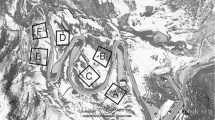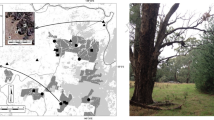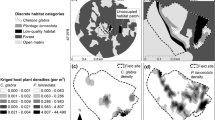Abstract
In contrast to many studies on the habitat quality of road verges for butterflies in relation to management regimes, little is known about whether road verges also function as corridors linking fragmented grassland habitats. We experimentally compared movements of four model species, two small blues and two medium browns, with one habitat specialist and one habitat generalist in each size and phylogenetic category. A total of 425 individual butterflies were caught and translocated to an experimental arena with three 2 × 30 m grassland strips that approximated road verges; one with adult feeding resources, one sheltered from the wind, and one without food and shelter. Movements in grassland strips were compared to movements in continuous grassland habitat. Results indicated that (1) individuals did not use the low-quality strip, (2) only specialists used strips but not in the same way according to their size and phylogenic category, and (3) strip use could not be predicted from habitat selection. This finding supports the idea that corridors of intermediate quality are the most efficient to promote dispersal rates in fragmented landscapes. Road verges cover 250,000 ha in Sweden, which is nearly the total amount of seminatural grasslands. Our results suggest that, to benefit butterfly dispersal among grassland patches, road verges should be managed to create a more favourable microclimate (e.g. sheltered from wind, high temperatures).


Similar content being viewed by others
References
Beier P, Noss RF (1998) Do habitat corridors provide connectivity? Conserv Biol 12:1241–1252
Binzenhöfer B, Schröder B, Strauss B et al (2005) Habitat models and habitat connectivity analysis for butterflies and burnet moths – the example of Zygaena carniolica and Coenonympha arcania. Biol Conserv 126:247–259
Brown JH, Kodric-Brown A (1977) Turnover rates in insular biogeography: effect of immigration on extinction. Ecology 58:445–449
Brunzel S, Elligsen H, Frankl R (2004) Distribution of the Cinnabar moth Tyria jacobaeae L. at landscape scale: use of linear landscape structures in egg laying on larval hostplant exposures. Landscape Ecol 19:21–27
Clausen HD, Holbeck HB, Reddersen J (2001) Factors influencing abundance of butterflies and burnet moths of an organic farm in Denmark. Biol Conserv 98:167–178
Dover JW (1997) Conservation headlands: effects on butterfly distribution and behaviour. Agric Ecosyst Environ 63:31–49
Dover JW, Fry GLA (2001) Experimental simulation of some visual and physical components of a hedge and the effects on butterfly behaviour in an agricultural landscape. Ent Exp Appl 100:221–233
Dover JW, Sparks TH, Greatorex-Davies JN (1997) The importance of shelter for butterflies in open landscapes. J Ins Cons 1:89–97
Eliasson CU, Ryrholm N, Holmer M et al (2005) Nationalnyckeln till Sveriges flora och fauna. Fjärilar: Dagfjärilar. Hesperiidae-Nymphalidae. ArtDatabanken, SLU, Uppsala
Fahrig L, Merriam G (1994) Conservation of fragmented populations. Conserv Biol 8:50–59
Fry GLA, Robson WJ (1994) The effects of field margins on butterfly movement. BCPC Monogr 58:111–116
Gerell R (1997) Management of roadside vegetation: effects on density and species diversity of butterflies in Scania, south Sweden. Ent Tidskr 118:171–176
Gilliam JF, Fraser DF (2001) Movement in corridors: enhancement by predation threat, disturbance, and habitat structure. Ecology 82:258–273
Haddad NM (1999) Corridor use predicted from behaviours at habitat boundaries. Am Nat 153:215–227
Haddad NM, Baum KA (1999) An experimental test of corridor effects on butterfly densities. Ecol Appl 9:623–633
Haddad NM, Tewksbury JJ (2005) Low-quality habitat corridors as movement conduits for two butterfly species. Ecol Appl 15:250–257
Haddad NM, Rosenberg DK, Noon BR (2000) On experimentation and the study of corridors: response to Beier and Noss. Conserv Biol 14:1543–1545
Hess GR (1994) Conservation corridors and contagious disease: a cautionary note. Conserv Biol 8:256–262
Hudgens BR, Haddad NM (2003) Predicting which species will benefit from corridors in fragmented landscapes from population growth models. Am Nat 161:808–820
Mech SH, Hallett JG (2001) Evaluating the effectiveness of corridors: a genetic approach. Conserv Biol 15:467–474
Merckx T, Van Dyck H, Karlsson B et al (2003) The evolution of movements and behaviour at boundaries in different landscapes: a common arena experiment with butterflies. Proc Roy Soc Lond B 270:1815–1821
Munguira ML, Thomas JA (1992) Use of road verges by butterfly and burnet populations, and the effects of roads on adult dispersal and mortality. J Appl Ecol 29:316–329
Norberg U, Enfjäll K, Leimar O (2002) Habitat exploration in butterflies – an outdoor cage experiment. Evol Ecol 16:1–14
Norusis MJ (1994) SPSS for Macintosh Release 6.1.1. SPSS. Chicago, IL
Noss RF, Beier P (2000) Arguing over little things: response to Haddad et al. Conserv Biol 14:1546–1548
Pollard E, Eversham BC (1995) Butterfly monitoring: interpreting the changes. In: Pullin AS (ed), Ecology and conservation of butterflies. Chapman and Hall in Association with Butterfly Conservation, London, pp 23–36
Pryke SR, Samways MJ (2001) Width of grassland linkages for the conservation of butterflies in South African afforested areas. Biol Conserv 101:85–96
Ries L, Debinski DM (2001) Butterfly responses to habitat edges in the highly fragmented prairies of Central Iowa. J Anim Ecol 70:840–852
Ross JA, Matter SF, Roland J (2005) Edge avoidance and movement of the butterfly Parnassius smintheus in matrix and non-matrix habitat. Land.scape Ecol 20:127–135
Saarinen K, Valtonen A and Jantunen J et al (2005) Butterflies and diurnal moths along road verges: does road type affect diversity and abundance? Biol Conserv 123:403–412
Schtickzelle N, Mennechez G, Baguette M (2006) Dispersal depression with habitat fragmentation in the bog fritillary butterfly. Ecology 87:1057–1065
Simberloff D, Farr JA, Cox J et al (1992) Movement corridors: conservation bargains or poor investments? Conserv Biol 6:493–504
Sisk TD, Haddad NM (2002) Incorporating the effects of habitat edges into landscape models: effective area models or cross-boundary management. In: Liu J, Taylor WW (eds) Integrating landscape ecology into natural resource management. Cambridge University Press, Cambridge, pp 208–240
Sjölund A, Eriksson O, Persson T et al (1999) Vägkantsfloran. Vägverket, Borlänge
Söderström B (2006) Swedish butterflies – a field guide. Albert Bonniers Förlag, Stockholm
Söderström B, Svensson B, Vessby K et al (2001) Plants, insects and birds in seminatural pastures in relation to local habitat and landscape factors. Biodiv Conserv 10:1839–1863
Stewart KEJ, Bourn NAD, Thomas JA (2001) An evaluation of three quick methods commonly used to assess sward height in ecology. J Appl Ecol 38:1148–1154
Sutcliffe OL, Thomas CD, Peggie P (1997) Area-dependent migration by ringlet butterflies generates a mixture of patchy population and metapopulation attributes. Oecologia 109:229–234
Système d’Informations sur la Biodiversité en Wallonie (2004) http://mrW.wallonie.be/cgi/dgrne/sibw/sibw.esp.list2.pl?VAR = papillons_diurnes. Cited 9 June 2006
Van Dyck H, Baguette M (2005) Dispersal behaviour in fragmented landscapes: routine or special movements? Basic Appl Ecol 6:535–545
Van Swaay CAM, Warren MS (1999) Red data book of European butterflies (Rhopalocera). Council of Europe Publishing, Strasbourg
Van Swaay CAM, Warren MS (2003) Prime butterfly areas in Europe: priority sites for conservation. National Reference Center for Agriculture, Nature and Fisheries, Wageningen, The Netherlands
Wiens JA, Stenseth NC, van Horne B, Ims RA (1993) Ecological mechanisms and landscape ecology. Oikos 66:369–380
Wood BC, Pullin AS (2002) Persistence of species in a fragmented urban landscape: the importance of dispersal ability and habitat availability for grassland butterflies. Biodiv Conserv 11:1451–1468
Acknowledgements
Many thanks to M. Franzén for validating data on habitat generalists and specialists. Å. Berg, T. Pärt and M. Baguette provided useful comments on the manuscript. This work was funded by the Swedish Research Council Formas.
Author information
Authors and Affiliations
Corresponding author
Rights and permissions
About this article
Cite this article
Söderström, B., Hedblom, M. Comparing movement of four butterfly species in experimental grassland strips. J Insect Conserv 11, 333–342 (2007). https://doi.org/10.1007/s10841-006-9046-5
Received:
Accepted:
Published:
Issue Date:
DOI: https://doi.org/10.1007/s10841-006-9046-5




